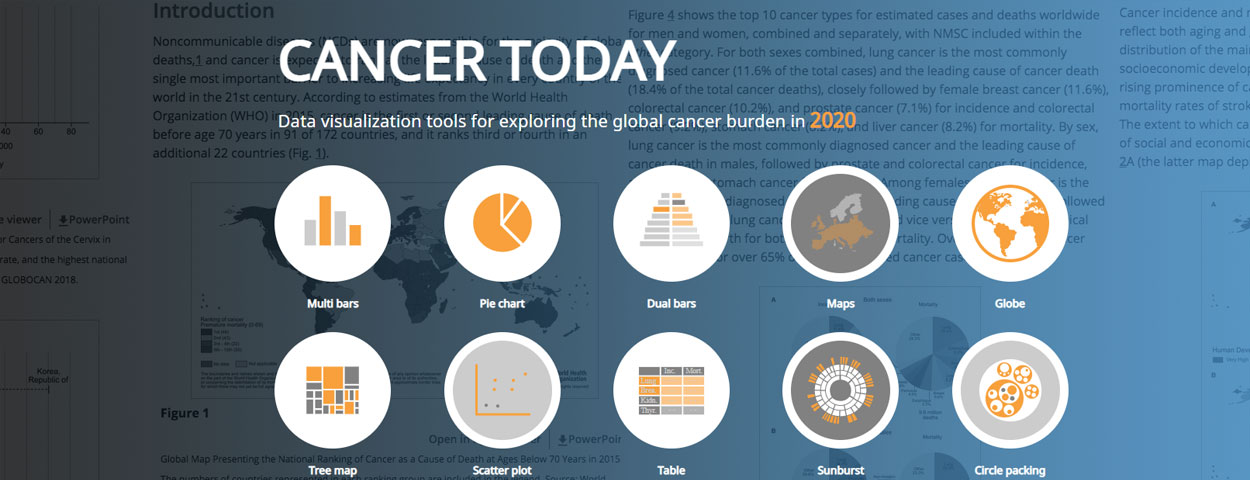More

The International Agency for Research on Cancer (IARC) today released the latest estimates on the global burden of cancer. The GLOBOCAN 2020 database, accessible online as part of the IARC Global Cancer Observatory, provides estimates for 2020 of incidence and mortality in 185 countries for 36 types of cancer and for all cancer sites combined.
There were an estimated 19.3 million new cases (18.1 million excluding non-melanoma skin cancer except basal cell carcinoma) and 10.0 million cancer deaths (9.9 million excluding non-melanoma skin cancer except basal cell carcinoma) worldwide in 2020. These figures, which are an update on the 2018 estimates, are made available through the IARC Global Cancer Observatory by country, cancer type, age, and sex.
The methods of estimation have not changed since the previous exercise, but the data have been updated. The most recent World Health Organization (WHO) mortality statistics have been used in the estimations, as well as up-to-date incidence data from cancer registries in several world regions and specific countries, including in sub-Saharan Africa, the Nordic countries, the Russian Federation, and Australia. We believe that the new estimates for 2020 are, as a result, more accurate than the previous ones for 2018. Given the changing data sources, the estimates are not fully comparable. Nevertheless, a notable observation in 2020 is that female breast cancer is now the leading cause of cancer incidence worldwide.
The estimated figure of 2.3 million new cases of female breast cancer in 2020 is only approximately 50 000 more than the estimated number of new cases of lung cancer. Each of these cancer types is responsible for more than 11% of the total cancer incidence burden. One of the underlying reasons for the increasing importance of breast cancer may be ongoing changes in key risk factors for breast cancer, including postponement of childbearing and having fewer children. These changes are most marked in countries that are undergoing major societal and economic change. Greater levels of excess body weight and physical inactivity are also responsible for the rising incidence of breast cancer worldwide.
Late-stage presentation is still very common in many countries that are undergoing social and economic transition, and there is a need for early and timely diagnosis of breast cancer, together with comprehensive cancer treatment.
Worldwide, an approximately 50% increase in the cancer burden is predicted between 2020 and 2040 due to demographic changes alone. The relative increase is most striking in countries that are undergoing social and economic transition, where greater levels of population ageing and growth are forecast over the next decades. This increase in cancer burden is paralleled by a changing profile of common cancer types, and many countries are experiencing a marked increase in the prevalence of known cancer risk factors that currently prevail in high-income industrialized countries, including smoking, unhealthy diet, excess body weight, and physical inactivity. Resource-sensitive preventive and curative interventions are available for cancer and need to be integrated into health planning at the national level. This is the critical means to reduce the future burden of cancer worldwide and narrow the increasing gaps between transitioning and transitioned countries.
A key remit of IARC is the regular provision of global estimates of the cancer burden. The methods of estimation still rely on the best available data on cancer incidence and mortality at the country level, including the Cancer Incidence in Five Continents (CI5) data series, the most recent data from the WHO Mortality Database, and more recent and new data from cancer registries, particularly in sub-Saharan Africa. The estimates for Europe were co-developed with the European Commission Joint Research Centre (JRC) and are also available as part of the JRC European Cancer Information System (ECIS) web application. Facilities for the tabulation and graphical visualization of the full data set of 185 countries and world regions by sex can be accessed via the Global Cancer Observatory (GCO) homepage (https://gco.iarc.fr).